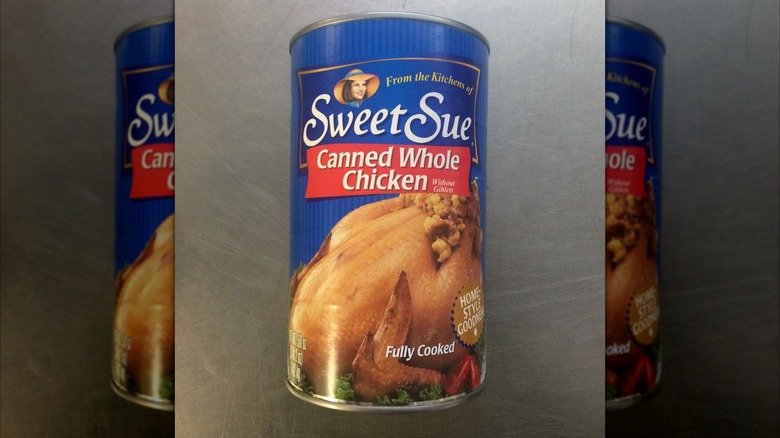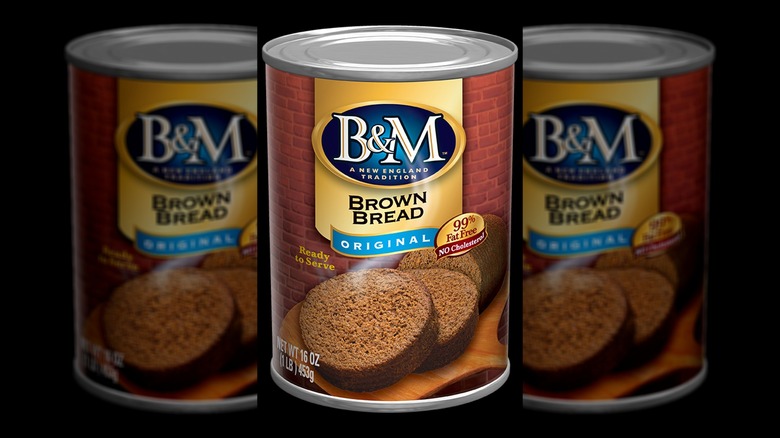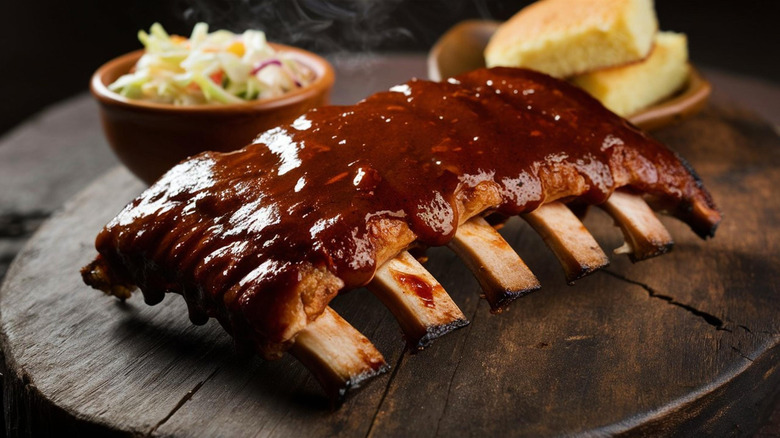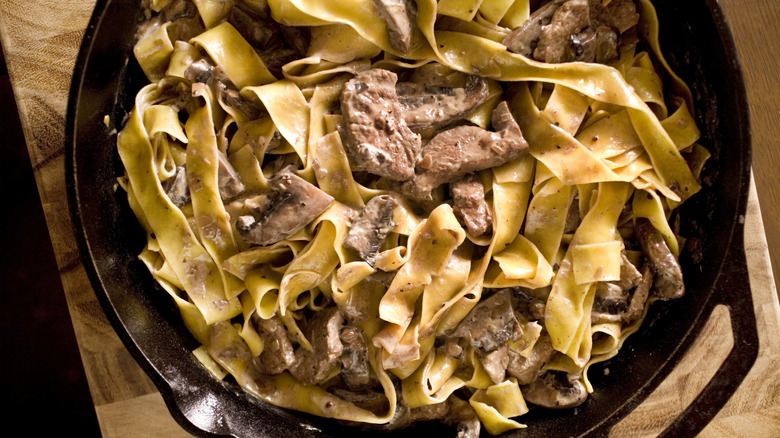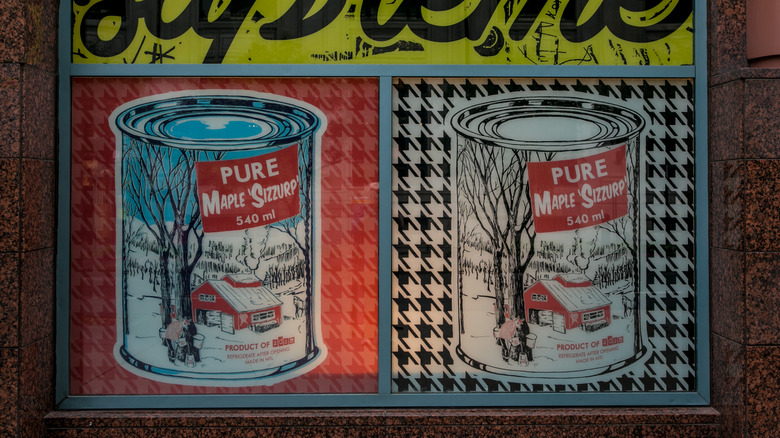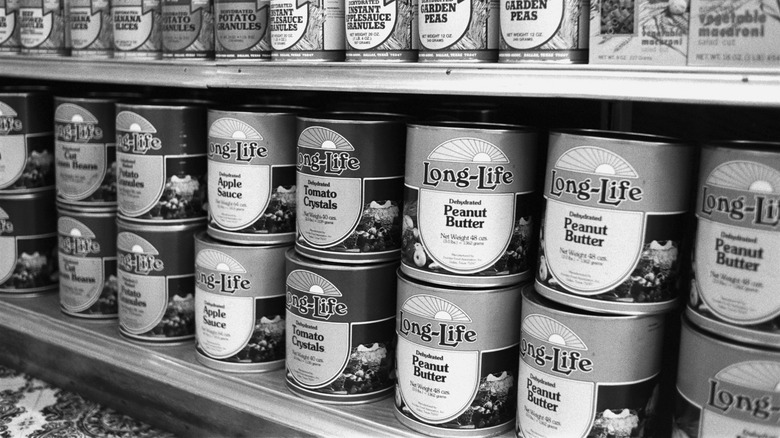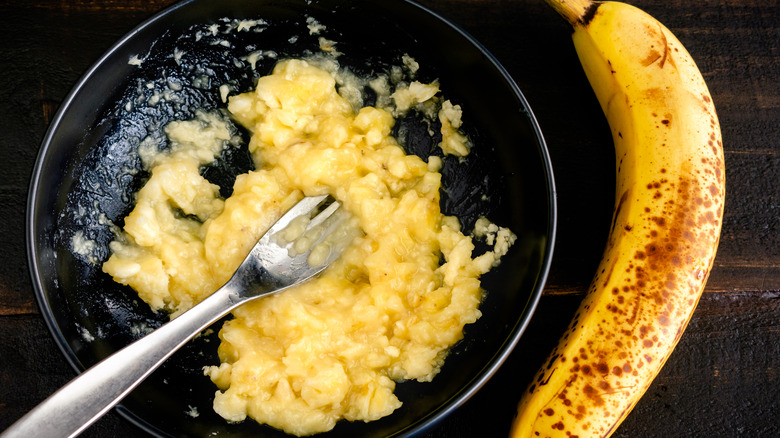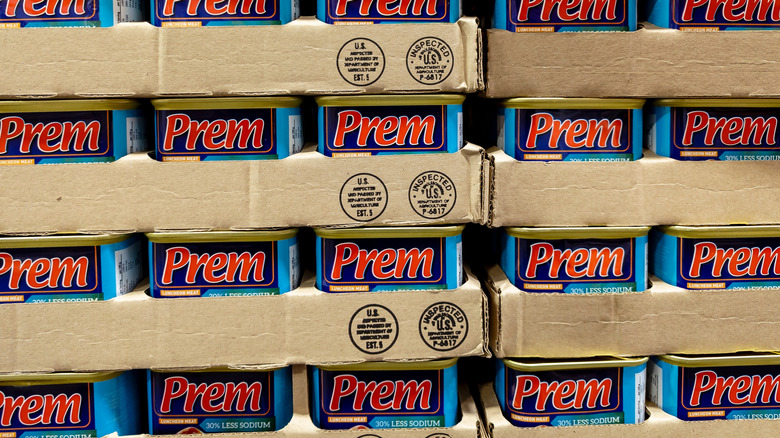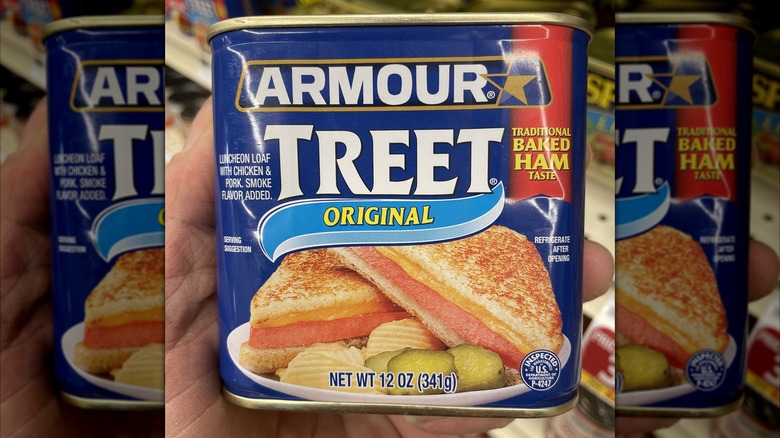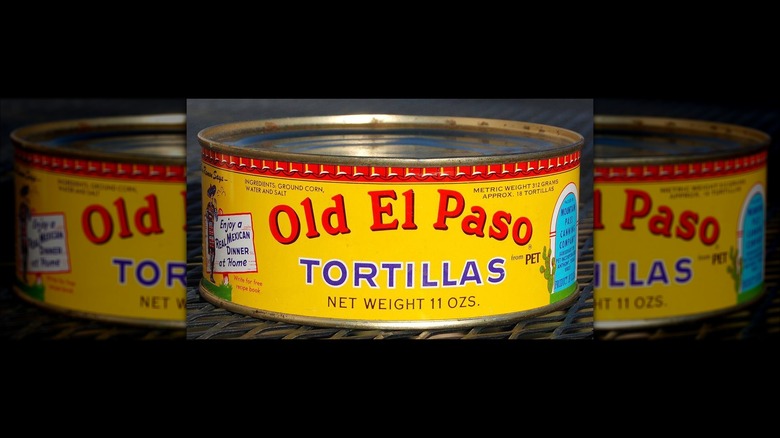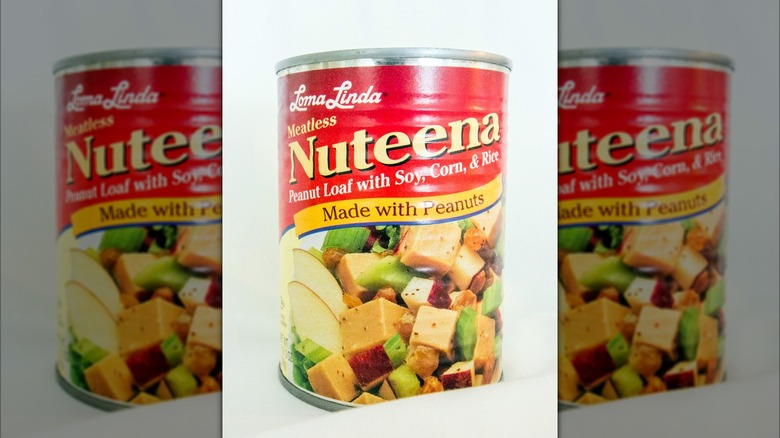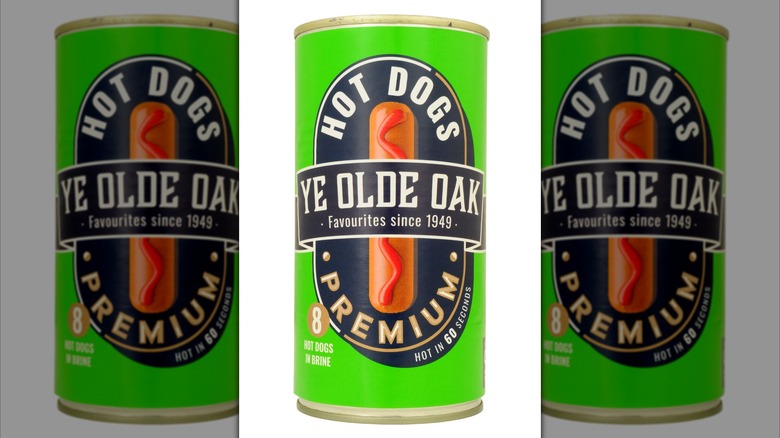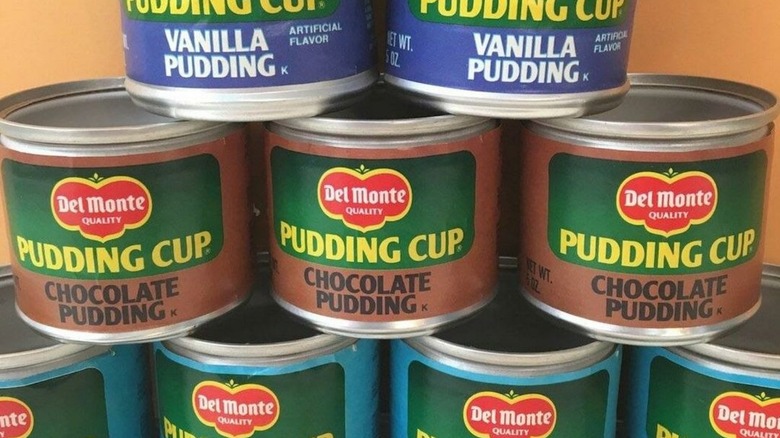14 Canned Foods People Stopped Eating
We may receive a commission on purchases made from links.
While most associate canned food with other grocery store convenience items like frozen foods and instant foods that came into the mainstream in the mid-20th century, if you look past traditional "canned" foods in glass jars (think Mason jars), you'll find that today's version of metal-canned foods can be traced all the way back to the early 1800s. At that time, a French chef, Nicolas Appert, was experimenting with packing foods into tin cans and then soldering the tin cans shut. He fine-tuned the process, canned foods grew in popularity, and it all eventually led to the double-seam cans we see today.
Canned foods are cheap, long-lasting, versatile, and delicious (even if they might not always be the healthiest option). Some canned foods have stood the test of time — one of the first foods that Appert canned was peas. Others have fallen in and out of vogue, and here are some of the weirdest and wildest canned foods that people have stopped eating.
Whole chickens
When you think of a whole chicken dinner, you probably imagine a perfectly cooked bird covered in a golden-brown, crinkling, shiny skin or something similar snagged from the grocery store rotisserie. Whatever you think of, you probably don't think of a pale, worse-for-wear bird that resembles a raw chicken at best and a naked mole rat at worst. However, this is what you get when you open up one of the large cans that contain a whole chicken. That's right — someone had the idea to take an entire chicken and stuff it into a can.
Canned chicken has been around for a while. Hormel sold this product in the mid-20th century. The chicken could go from can to plate in seconds for jellied, cold chicken, or you could transform it by basting or breading it and then frying, broiling, or roasting it. Other suggested uses included soups and gravies. As of 2013, you could still buy this interesting culinary creation from the Sweet Sue brand, but now it looks like that's not an option.
Bread
The most recognizable canned bread comes from the brand B&M, which first began selling the canned food in 1928 and still does today in both standard and raisin bread variants. However, a version of canned Boston brown bread existed at least a few decades before in the 1800s — Home cooks steamed bread inside of cans, seemingly just in order to achieve a round, molded shape rather than to preserve the bread for a long period of time.
The bread was particularly popular in New England in the past and remained popular until just a few decades ago (though it did see a brief resurgence via social media in 2020 — maybe as the antithesis to the Covid homemade sourdough craze). Some who lived with it in the 1960s and 1970s remember the canned bread fondly as a part of family dinners, while others shudder at the memory. The bread could be served as a dessert but also alongside savory dishes, such as baked beans or hot dogs.
Ribs
Similarly to a whole chicken, a rack of ribs isn't really something you might think is suitable for shoving into a can. But, that's what Armour Star did in 1963. The brand sold canned, fully cooked, ready-to-serve ribs in barbecue sauce weighing in at 2 ½ pounds of ribs per can. The brand pitched the offering as a more affordable, convenient alternative to typical ribs.
If you're among the few who say they'd definitely still try this canned food today, you might not be able to walk into your average grocery store and find them. If you travel to Scotland, you can find the Scottish brand Grant's selling boneless beef ribs in a can. But really, without the bones, is this any different from pulled barbecue pork or beef in a can?
For those seeking a super-fast barbecue rib solution, refrigerated options are usually available in the grocery store meat aisle. You only need to remove them from some plastic packaging, heat, and eat — no can opener required.
Beef stroganoff
Beef stroganoff is one of those divisive dishes that most people either love or hate. Invented in the early 1800s (just like modern canning itself), most popular in the 1950s and 1960s in the United States, and named after a Russian noble, the dish blends beef, onions, and some sort of creamy sauce that differs according to your recipe. It often pairs well with egg noodles, mashed potatoes, or rice.
While not difficult to pull together, some decades ago, someone decided to make compiling this dish even easier by putting it in a can. One brand to do so was Neo-Life with its 1970s Stroganoff-Style Casserole. Today, the closest you'll get to this is likely Hormel's heat-and-eat stroganoff, but it comes in a plastic, microwave-safe dish and not a can.
Canned stroganoff leaves a lot to be desired and, much like any canned meat-and-pasta dish, doesn't hold a candle to the real deal. Frankly, it doesn't look like it can even hold a candle to some of the stroganoff kits you'll find in the grocery store today, such as those offered by Hamburger Helper.
Maple syrup
Typically, your maple syrup packaging options are limited to just two choices: plastic or glass. If you're going for the more affordable option, plastic it is. If you want the real deal, you might go for a little glass jug. What you're not going to find in most instances is a can of maple syrup. Standard, cylindrical maple syrup cans were quite popular in the late 1800s and into the 1900s. Rectangular tin cans were also favored in some areas, particularly in New England, akin to what you might see some olive oil sold in today.
You can still sometimes find maple syrup in a can if you know where to look. In Quebec, the can is still a common method for storing maple syrup. If you want to try this canned food, it's possible, but you may have to go out of your way. It's certainly not the standard for most American consumers anymore.
Peanut butter
Similar to maple syrup, today's peanut butter comes in a plastic jar across the board (unless you buy it in a squeeze pouch for snacking). One thing that you won't see in the grocery store is peanut butter in a can — and yet, that was a thing, too, before plastic packaging became mainstream.
Peter Pan (a brand name you likely recognize) sold peanut butter in a can in giant quantities at one point — as much as 25 pounds! A lesser-known brand, Bengal Brand from St. Paul, Minnesota, sold peanut butter in smaller, 14-ounce cans. Additionally, in the 1960s, the U.S. Department of Agriculture canned peanut butter for distribution to families in need. This was called government peanut butter and was similar to government cheese.
Today, you won't find basic, standard-issue peanut butter in cans. However, you can find peanut butter in can designed specifically for long-term storage.
Banana flakes
You can buy dehydrated banana chips for snacking or use in trail mix, but what about banana flakes? That was one of the many canned foods that you could buy a few decades ago that have simply fallen out of favor today. But, what were they used for?
One vintage can of Kanana-brand banana flakes promotes the ingredient as similar to potato flakes. Just like you'd use potato flakes to make instant mashed potatoes, you could use banana flakes to make instant mashed bananas. The flakes also worked as a sweetener, a mix for a milk-based beverage, or a yogurt topping. When mixed with milk or water, you only needed a tablespoon of banana flakes to get about the same amount of product that you'd get from a quarter of a banana.
You can still buy banana flakes, but they're not marketed in the same way. Instead, they're promoted as a health product and as a relief for diarrhea and heart burn.
Prem
All of the above items might seem a little odd in canned form, but they're still more or less recognizable. For this canned food, though, you probably don't even recognize the name. You may be more familiar with one of this food's competitors: Spam.
Like Spam, Prem was a canned meat sold in the 1940s. It could be eaten cold or cooked and served hot. It could be sliced and served on a platter or on a sandwich. It came in a little square can just like Spam.
While articles as recent as 2018 purported that Prem was still being sold by Zwanenberg Food Group, that doesn't seem to be the case today when looking through the various Zwan products available online. If you want to try something similar, the brand does sell all manner of other interestingly packaged meat products, such as chicken luncheon meat in a tube.
Treet
Here's another vintage canned food find that may be unfamiliar in name but is also relatively close to both Prem and Spam. A Spam-like canned meat first sold in the 1930s and growing in popularity throughout the mid-20th century, Treet was produced by Armour Star and was made with all pork.
You can still buy Armour Treet today. But, since it's been wildly eclipsed by Spam in popularity and the public consciousness (Spam has become a part of the lexicon, but who knows Treet?), you may have trouble finding it. Today, Armour Treet is made with chicken, pork, and smoke flavoring, though the classic rectangular can promises it still offers a "traditional baked ham taste." According to a Reddit review comparing Treet with Spam Lite and Walmart's house brand canned meat, Treet is less expensive than Spam, Treet has more calories, fat, and sodium than the other two options, and the flavor is salty and slightly metallic.
Tortillas
In the 1970s, Old El Paso sold corn tortillas in a can. Each can included about 18 tortillas, and you could fry the tortillas in oil after popping the can open. Some who remember eating the canned tortillas say they were terrible; others, though, say that they were pretty flavorful. They were also a sign of the times — throughout the 1970s and 1980s, Tex-Mex cuisine began growing in popularity with American home cooks nationwide. Before the supply chain could catch up to popular demand, these canned tortillas were often a must-have when traveling to areas of the country far from Texas and Mexico where access to fresh tortillas was out of the question.
Of course, you can now simply go to any grocery store and pick up a plastic bag of tortillas or a box of taco shells. You can also make your own tortillas at home, and it's far simpler than you're expecting.
Nuteena
America's meat-lovers had their canned foods in Spam and Treet, but what about the vegetarians and vegans? They weren't just limited to the canned vegetable and fruit aisle during America's canned food heyday. They had their own canned meat alternative known as Nuteena.
Sold from the 1960s to 2005 and produced by Loma Linda, Nuteena was a peanut-based loaf product that also contained soy, corn, and rice. You could slice it and eat it, spread it onto a sandwich, or add it to larger dishes like you might a meat product. During the time of production, Nuteena amassed quite the cult following. You can find many articles and social media posts bemoaning the product's loss, as well as copycat recipes that promise to replicate the canned food's flavor and texture at home. While you can no longer find Nuteena, Loma Linda does still produce a variety of other canned meat alternatives, such as Tuno, a tuna alternative made from soy protein.
Hot dogs
You probably are familiar with Vienna sausages in a can — little miniature chicken and pork sausages cooked in chicken broth and usually eaten straight out of the can or alongside some crackers. But, what about full, regular-sized, all-American hot dogs in a can? In the 1950s, Oscar Mayer sold hot dogs in a can and conveniently packaged them with a pouch of barbecue sauce included between all of the dogs.
Today's hot dogs are typically sold in plastic packaging, just like a wealth of the other foods that were once canned. However, if you really want to try a canned hot dog, you can try your luck on Amazon. You can also find vegan canned hot dogs sold by Loma Linda, the same brand responsible for Nuteena. You can also still find canned hot dogs and jarred hot dogs in other countries, such as Sweden and Germany.
Cheeseburger
Out of all of these various canned foods, there's one thing that's pretty much consistent — all of the canned items are a singular food or ingredient. That's not the case when it comes to canned cheeseburgers. A conglomeration of all the various ingredients that make a cheeseburger great, this canned food is not vintage in the slightest, but its day in the sun has passed.
Invented in 2008, the cheeseburger in a can is intended to be boiled while it's still in the can and then eaten. The canned food was marketed toward hikers and campers. While it enjoyed a bit of limelight when it was first introduced, it quickly fell out of favor, most likely due to the lack of positive reviews. Though some did say it at least fit its purpose — eating in the wilderness — and while soggy, it was flavorful. You can no longer find the product on the maker's website nor on Amazon.
Pudding
Pudding cups are well-known and recognizable. You probably ate them plenty of times as a kid. They come in plastic cups with a foil lid that you rip off and lick before discarding and digging in. However, if someone handed you a pudding cup from the 1980s, you'd probably be pretty confused — in the 1980s, pudding cups didn't come in cups. They came in cans (but were still called pudding cups, confusingly).
Produced by Del Monte and emblazoned with "pudding cup" on the side, these pudding cups were really just small, normal cans. They look similar to what you might see Vienna sausages in today, complete with the pull-tab top and everything. Of course, selling an item like this primarily marketed toward children came with its dangers, namely the can's and its lid's sharp edges. Still, that doesn't mean that there aren't folks who wish that Del Monte would bring back pudding cups in a can — there's even a Facebook group dedicated to the cause.

